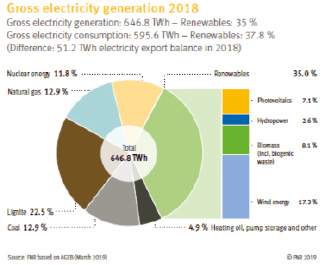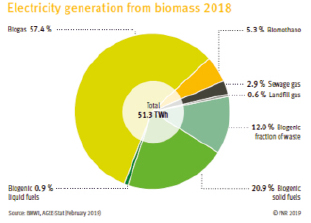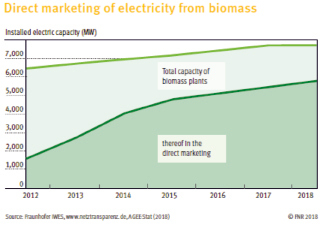Studying the foreign experience of agricultural production in Russian and foreign languages is one of the components of the system of agrarian and technological higher education. To develop the professional competencies of specialists in the field of agricultural energy supply, it is necessary to turn to modern information sources of European leaders.
The purpose of the study is to consider the potential opportunities, obstacles and necessary framework conditions for the use of biogas for the production of electricity on a small and medium scale at agricultural enterprises in Germany and Russia.
Materials and research methods
The article is written on the basis of empirical material from modern scientific and journalistic sources in Russian, German and English. Methods of comparative analysis and theoretical review of foreign language specialized literature are necessary for a full-fledged research work. [1]. This article also uses the specified technology for working with domestic and foreign sources on the topic “Electricity production in biogas plants”.
Research results and discussion
Bioeconomics, as an independent modern branch of the national economy of European countries, works to strengthen the stability of many related industries: agriculture, processing industry, energy. Biogas production in particular is a promising area for agricultural development both in EU and in Russia. [2].
Biogas is formed as a result of the process of anaerobic digestion. The biogas plant processes green biomass, farm manure, agro-industrial waste and slaughterhouses into combustible gas. Biogas can be used in the same way as conventional natural gas in gas furnaces, lamps, or as a motor fuel. Composition of biogas: 50-75 % methane, 25-45 % carbon dioxide, 2-8 % water vapor and traces of O2N2, NH3 H2 H2S. If we compare biogas with natural gas, the energy content of methane in natural gas is much higher: from 80 to 90 %. Therefore, the quality of gas raw materials is determined by the high content of methane. Even with serious cleaning, the gas will contain carbon dioxide and water vapor. But sulfur impurities should be kept to a minimum, especially for use in engines. [3;4].
The productivity of a biogas plant in agricultural production depends on many factors: the initial raw material, the design features of the plant, the heat and fermentation time. One of the objectives of our study is to consider these experimental facilities for generating electricity in Russia.
Experience in introducing biogas plants in Russia. The development of biogas in Russia requires the support of the state. In 2030, the Ministry of Energy of the Russian Federation plans to reach the indicator of 10 % of the energy received from alternative sources.
There are two ways to organize biogas production sites in Russia: the construction of industrial stations and the construction of modular plants of factory production. The first type of biogas plants is a cylindrical modular horizontal reactor with batch mixers. The second type has vertical reactors, which are usually mounted at the installation site. [5].
There is currently no large alternative energy production in Russia because the cost of building industrial biogas power plants is five to seven times higher per kW / h than traditional. The plants that operate now are not business projects that would pay off and generate profit, but pilot capacities demonstrating the possibilities of alternative energy. They are introduced near sources of raw materials (agricultural production) selling energy equipment companies.
However, despite all the difficulties faced by today’s farmer, there is a certain interest of farmers in the construction of biogas plants. The constant jumps in the cost of energy purchased on the side, as well as the significant costs associated with the disposal of organic waste make us seriously think about generating our own energy using our own resources. But this interest is not stable and fragmented and rarely comes to serious business projects. The existing projects in Russia were built with the support and investments of foreign financial and industrial companies. Thus, the Luchki biogas station in the Belgorod Region (annual electricity production of 19.6 million kW / h), built by Alt-Energy production company, used Big Dutchman Agro equipment.
For example, the MosMedynAgroprom installation, which opened in 2009, was built by BioGazEnergoStroy with a loan of € 750 million from an equipment manufacturer Landesbank Berlin in installments for 18 years. The investment in the BioGazEnergoStroy installation does not justify. According to the calculations of market participants, they are at the level of € 100 million. Accordingly, the experience turned out to be inconsequential: the station is used at 50 % of the capacity with which it ensures the operation of livestock buildings. The biogas plant is located in close proximity to the livestock complex and auxiliary devices, such as: screws, pumps, etc., The remaining 50 % of the power is not used, because there is no way to connect to the network and realize excess energy [6].
A more successful pilot project is in the Belgorod region, but its success directly depends on the support of the regional administration. Another example is the Baytsury biogas station. The station supplies energy to the network for 9 rubles. per kWh, with a 5 % surcharge, but even at this rate, the project will become self-sustaining in 8–9 years. And if kilowatts were purchased at the market price, then the money would be returned at least 15 years later. The “Regional Biotechnology Center” predicts that after reaching self-sufficiency, the cost of producing a kilowatt will be 2 rubles, which is not much higher than the cost of traditional energy.
The group of companies “Agrobiotechnology” claims that the payback of projects directly depends on the processed raw materials. Plants processing high-fat products such as sugar pulp, slaughterhouse waste, etc., can cost up to € 2,000 per kWh of installed capacity. For waste with a lower fat content, such as cattle manure with a long fermentation time, high humidity and low (less than 20 cubic meters / ton) biogas output, the cost of a kilowatt will already be € 6-7 thousand. On average, investments in equipment for the production of a kilowatt of alternative electricity (“turnkey” and with a cogeneration plant, with construction and design) are at the level of € 3-5 thousand [5].
Among the serious problems faced by biogas electricity producers there are also legislative and administrative obstacles. According to the owners of biogas electricity, they cannot supply resources to local electricity networks due to the lack of “established tariffs” [6]. According to Federal Law No. 35, electricity from a “renewable” source can be purchased “at a fixed rate” to compensate for losses in the power grid [7]. But these tariffs to date in Russia, unlike Europe, have not been determined. Additional obstacles to the sale of renewable energy are the very complex and expensive technical conditions for connecting to the networks of the sales company, which make alternative projects completely unprofitable.
There are still positive examples of generating own electricity at Russian farms. As a rule, these are small autonomous alternative energy projects designed for own consumption, without connecting to traditional networks. For example, the Perm company EnergoRegim, under the leadership of Vladimir Rashin, is constructing small biogas plants with subsequent installation in farms in Udmurtia, the Orenburg, Rostov regions and in the Perm Territory. [6]. The purpose of these enterprises is not to profit from energy sales (the profitability of alternative energy is usually zero), but their own energy independence and the solution of the problem of waste disposal, production of bio-fertilizers.
Nevertheless, the experience of foreign countries shows that the production of electricity from biogas can be widespread and develop large capacities. For the purpose of comparative analysis, we turn to the European leader in alternative energy – Germany.
In Germany, the main types of biogas raw materials are biomass from energy crops and manure. Practical experience of using biogas plants in Germany has shown that the most common raw material – corn silage gives an output per ton of raw materials about 8 times more than cow manure. Two conventional units of live cattle (2 cows or 12 pigs) and a maize field of 1 ha will give a constant output of electricity of about 2 kW (48kWh per day) [8].
One of the options for direct conversion of biogas to electricity is carried out by using a fuel cell. In this case, a highly purified gas must be used. Economically, this requires high costs for expensive fuel cells. Therefore, this method of production is more the subject of scientific research than practical application. The most common method is to convert biogas into electrical energy using a generator set. Biogas serves as fuel for an internal combustion engine that converts combustion energy into mechanical energy. This drives an electric generator to generate electricity. The design of an electric generator is similar to that of an electric motor. Most generators produce alternating electrical voltage. Corresponding electric generators are available in almost all countries and in all sizes. This technology is quite well known and its maintenance process is simple. In most cases, even universally available three-phase electric motors can be converted to generators. Technologically, the first stage of the generator set is much more complex: an internal combustion engine that uses biogas as fuel. In theory, biogas can be used as a fuel in almost all types of internal combustion engines, such as gas engines (Otto engine), diesel engines, gas turbines and Stirling engines, etc. [3; 4].
Next, we provide statistics on electricity generation from biofuels from Library of Agency for Renewable resources, Germany (fig. 1, 2, 3).

Fig. 1. Gross electricity production 2018 [9]

Fig. 2. Electricity production from biomass 2018 [9]

Fig. 3. Direct marketing of electricity from biomass [9]
Most of the electricity produced from biomass in Germany (54,7 %) comes from biogas (fig.2). For agricultural enterprises that producing electricity from biogas, not only energy consumption for their own needs, but also for sales purposes, plays a major economic role (fig. 3).
From the diagram we see that for 2018 the installed electric capacity was approximately 7,500 MW of the total biomass production, of which approximately 5,500 MW was used for direct marketing. From an economic point of view, electricity from biogas can be no less profitable than from fossil fuels and other alternative energy sources.
At the same time, there are stimulating and restraining economic factors.
Supporting factors are:
– Rising prices of fossil fuels
– Low reliability of electricity provision from national grids with persistent risk of power cuts and vulnerability of hydro power to drought.
The stimulating factors are:
– increase in the cost of traditional energy carriers
– disruptions in power supply from external suppliers, the dependence of hydropower from drought
The constraints are:
– falling prices for traditional energy carriers;
– lack of technical independence, the need to purchase expensive equipment;
– unfavourable economic and undeveloped legal conditions for the sale of alternative electricity;
– lack of information and inexperience hinder the development of infrastructure and the economy of enterprises.
In the economy of biogas plants, a large role is played by the entire list of products produced. It includes:
– electricity or mechanical force;
– biogas;
– warm;
– saving on utilization of waste and effluents of agro-industrial facilities;
– use of waste as fertilizer [9].
In Germany electricity generation from biogas is only profitable due to the connection to networks and subsidization of tariffs for the supply of energy. German experts studying the implementation of technologies for generating electricity from biogas note that in countries such as Russia, there should be financial and legal state support for the supply of electricity from biogas power plants. [8]. At the same time, result – oriented support schemes (such as the German EEG – law on renewable energy sources) show themselves to be more successful than investment-oriented financial support.
For experimental biogas plants, direct subsidies and state co-financing to cover installation costs are of great importance. But this is not enough to ensure efficient operation and production. A much larger role for biogas plants is played by regulatory fixing of tariffs for raw materials and energy sales.
Therefore, in the framework of projects and programs of technical cooperation, it is recommended to create a system of guaranteed prices for raw materials, similar to those that existed in Germany. However, in addition to price considerations, there are still many barriers to market entry and development of the biogas sector.
As a result of studying domestic and foreign sources on the topic of the study, we conclude:
A review of the implementation, functioning and economics of biogas-based power plants in Russia shows that there are many technical problems, as well as of legal and economic nature. The main goals of using domestic alternative energy are the energy supply of own production and the disposal of biological waste on farms. The experience of Germany, on the contrary, shows the purpose of biogas power plants as energy production for the purpose of sales and profit. State support measures play here a significant role, giving tariff regulation and the creation of a favorable legal field for alternative electricity.
Conclusion
As a summary, we give the main framework barriers, overcoming of which will enable us to reverse the situation of sustainable energy for the better:
– lack of information about the possibilities of using biogas;
– high cost of evaluation of the economic potential and the initial technical calculations;
– lack of financial support;
– lack of a trained expert group for the construction, maintenance and operation of installations;
– legal barriers that serve as barriers to the production and sale of alternative energy at the Federal and local levels.
Until the national framework conditions are favorable, electricity generation from biogas will continue to be limited to a few pilot proposals.
Библиографическая ссылка
Третьякова А.Н., Журавлева Н.Н. ПРОИЗВОДСТВО ЭЛЕКТРИЧЕСТВА ИЗ БИОГАЗА В РОССИИ И ГЕРМАНИИ // European Journal of Natural History. – 2020. – № 3. – С. 157-161;URL: https://world-science.ru/ru/article/view?id=34107 (дата обращения: 23.04.2024).

